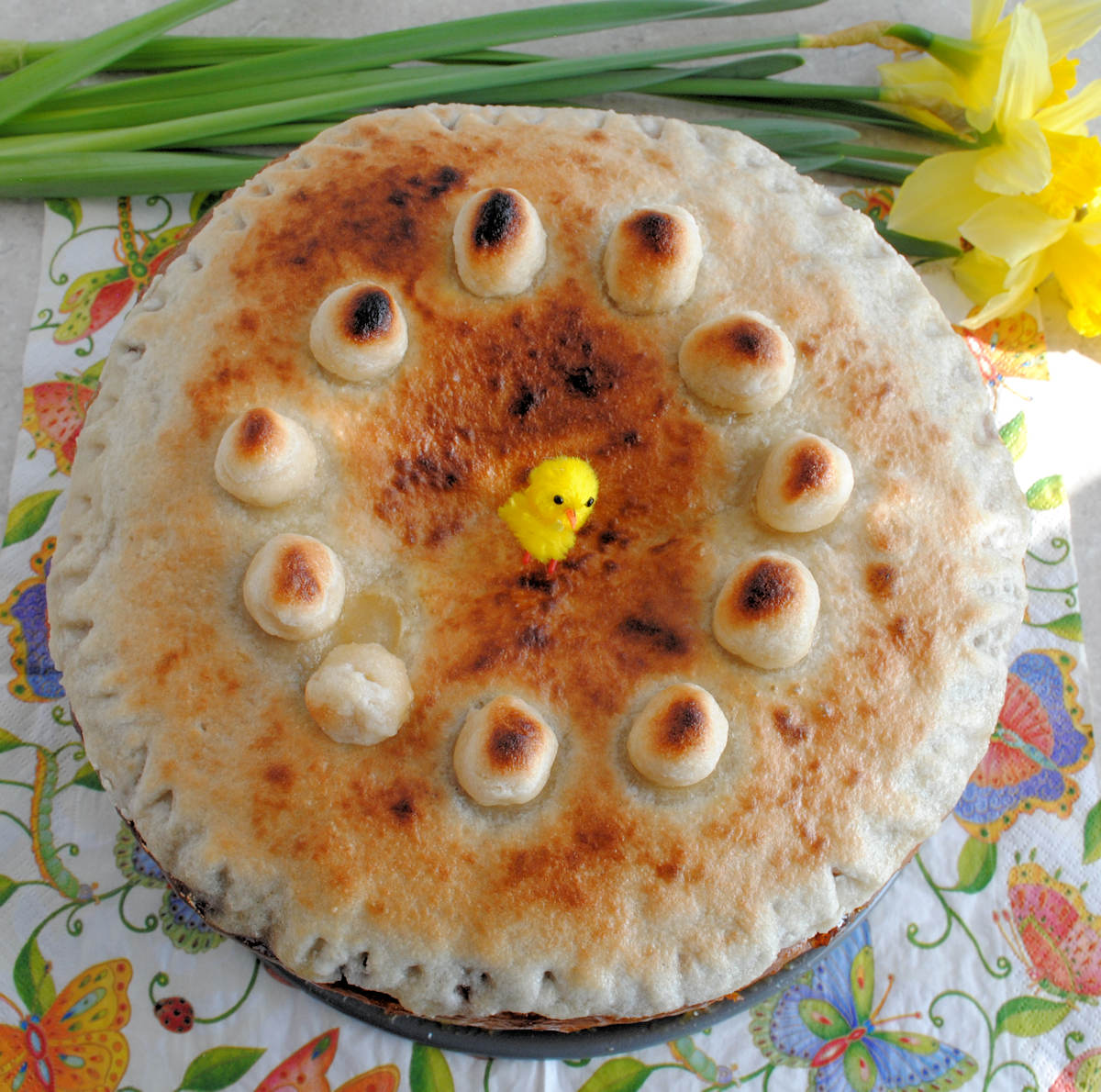The most traditional version of English Easter Simnel cake: rich and fruited yeast dough with two marzipan layers and marzipan balls symbolising eleven apostles (Judas did not qualify).

Simnel cake history
Traditional Simnel cake goes back to medieval times. As most festive bakes, it was about enriching the dough with as much fruit and spice as one could afford. 'Simnel' derives from the Latin word simila: finest wheat flour, so the bake was certainly for a special occasion.
The bready, fruity loaf was apparently then encrusted in pastry, presumably for preservation and that was subsequently replaced by marzipan layers in the middle and on top of the cake. It is possibly all that remained from the total encasing in first pastry, then marzipan - and rightly so because it is still awfully rich as it is now.
This is Simnel cake made with yeast dough, which means going back to the roots of this Easter bake, via English Bread and Yeast Cookery by Elizabeth David and Dan’s Bread, Cakes And Ale blog which I based my recipe on.
I am a sucker for yeasty dough which is how the best festive concoctions are made. Panettone, Colomba Pasquale, Stollen and hot cross buns are all sweetened, enriched breads. I was also curious to see how the 'bread' version would compare to the modern variety which, basically, is just like the Christmas cake without so much booze and fruit.
This version of Simnel is like giant teacake baked in a tin. Instead of icing it is crowned with the famous eleven balls of marzipan set on a marzipan floor. Apart from fruit and candied fruit (let's be honest: just glace cherries, this is a British cake after all) there is the second layer of marzipan going across through the middle.
Make your own marzipan
I warmly encourage everyone to make your own marzipan. There is absolutely no comparison between the crumbly sugary plank of weirdly yellow or brightly white stuff bought from shops and the fragrant, pliable almond paste which it takes only a minute to make.
This recipe has the easy English version with an egg white but dive into my Stollen recipe for the instruction on German raw marzipan which is even better. A note on the egg white: with this amount of sugar for company, the raw (or lightly grilled) marzipan is perfectly safe to eat.
Rich yeasted dough
Yeast-leavened dough is definitely an easy job with the help of a standing mixer or a handheld one with a dough hook attachment. By hand it will be sticky, take a very long time and give you enormous artisan satisfaction. The trick to knead it briefly at ten minute intervals does help.
It proves in bulk, as yeast doughs do, then is divided in two, to be separated by the marzipan layer, and left to rise again in the tin.
Caution: the middle-of-the-cake marzipan layer might sometimes go walkies a little and/or partly melt. When I first made my yeasted Simnel I thought it had collapsed in the middle, but it was only the marzipan bunched up somehow in the centre, having refused to stay in a tidy layer.
Marzipan topping
And finally the fun bit: the marzipan topping and balls.
Roll them up from the offcuts that you manage to restrain yourself from scoffing. The lovely scorched appearance is best made with a cook's blowtorch but I don't expect everyone to own it since I don't: preheat the oven grill and briefly and carefully place the cake underneath it, turning and closely watching it.
More festive bread recipes
Cinnamon twist star bread, a variation on the kanelbullar, Swedish cinnamon buns, theme. A giant kanelbulle twisted into a star bread shape, with cinnamon, apple and chocolate fillings.
Julekake (pronounced yoo-le-kar-ka) is a traditional Norwegian Christmas bread, with Sukat (candied citrus peel) and raisins. Julekake is flavoured with cardamom and it’s best toasted, served with gjetost (brown cheese).
Italian pandoro cake is a traditional Christmas and New Year confection, baked in a tin shaped like a star. The main difference between pandoro (meaning ‘bread of gold’) and panettone is the lack of dried and candied fruit in the former. It’s still very rich and buttery, decidedly more a cake than bread.
More marzipan recipes
Danish marzipan kringle, the perfect cake for festive times is easier to bake than most Christmas breads and it is insanely delicious. Especially with homemade marzipan remonce (filling).
Marzipan loaf cake based on Nigella Lawson’s recipe, using homemade marzipan. That’s a simple plain cake with marzipan in the mix but there’s nothing plain about the way it tastes.
Marzipan and shortbread biscuit chocolate coated bars, made from scratch. Like Twix, only better; like Ritter Sport’s all best bars combined into one.